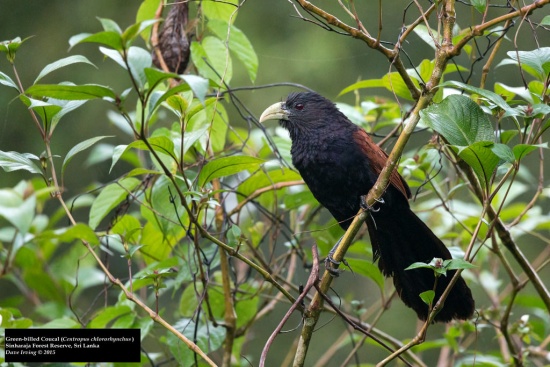m (→Distribution) |
(Clearer image added) |
||
| (7 intermediate revisions by 5 users not shown) | |||
| Line 1: | Line 1: | ||
| − | [[Image: | + | [[Image:Green-billed Coucal 2.jpg|thumb|550px|right|Photo by {{user|Dave 2x|Dave 2x}}<br />Sinharaja, [[Sri Lanka, ]]March 2015]] |
;[[:Category:Centropus|Centropus]] chlororhynchos | ;[[:Category:Centropus|Centropus]] chlororhynchos | ||
==Identification== | ==Identification== | ||
| − | + | 43 - 46cm. | |
| + | * Black head, body and tail | ||
| + | * Neck and tail with purple gloss | ||
| + | * Chestnut wings | ||
| + | * Ivory to pale green bill | ||
| + | Sexes alike but females are larger. Juveniles are similar to adults but their eye is grey (not red) and the bill is greenish with a dark grey base and culmen. | ||
| + | ====Similar species==== | ||
| + | Similar to the more common [[Greater Coucal]]. Note the green bill, the darker chestnut wings and the purple gloss (blue in Greater Coucal). | ||
==Distribution== | ==Distribution== | ||
| − | Endemic. Found locally in wet zone of south-western [[Sri Lanka]], especially in Sinharaja Rain | + | Endemic to [[Sri Lanka]]. Found locally in wet zone of south-western [[Sri Lanka]], especially in [[Sinharaja]] Rain Forest and at [[Kitulgala]].<br /> |
| − | + | A rare and still declining species, threatened by continued loss of forest to agriculture. | |
==Taxonomy== | ==Taxonomy== | ||
| − | This is a [[Dictionary_M- | + | This is a [[Dictionary_M-O#M|monotypic]] species<sup>[[#References|[1]]]</sup>.<br /> |
The scientific name is sometimes spelled ''chlororhynch'''u'''s''. | The scientific name is sometimes spelled ''chlororhynch'''u'''s''. | ||
| + | |||
==Habitat== | ==Habitat== | ||
| − | + | Found in humid high evergreen forests with dense undergrowth in the wet zone of the island. Often in bamboo and rattan cane. From lowlands up to 800m. | |
==Behaviour== | ==Behaviour== | ||
| − | A very shy and elusive bird, | + | A very shy and elusive bird, better known by its calls than by sight. |
| + | ====Diet==== | ||
| + | [[Dictionary_M-O#O|Ominvorous]]. Forages on the ground and in trees and creepers. | ||
| + | ====Breeding==== | ||
| + | Breeding season mainly May to July. The nest is domed or globe-shaped and made of twigs, roots and grass. It's built near the ground. Lays 2 to 3 eggs. | ||
| + | ====Movements==== | ||
| + | This is a resident species. | ||
====Vocalisation==== | ====Vocalisation==== | ||
Recorded by {{user|Andrew+Whitehouse|Andrew Whitehouse}}<br />Kithulgala, [[Sri Lanka]], July 2010 | Recorded by {{user|Andrew+Whitehouse|Andrew Whitehouse}}<br />Kithulgala, [[Sri Lanka]], July 2010 | ||
| Line 18: | Line 32: | ||
''[[Media:Green Billed Coucal Kithulgala 160710.mp3|Listen in an external program]]'' | ''[[Media:Green Billed Coucal Kithulgala 160710.mp3|Listen in an external program]]'' | ||
==References== | ==References== | ||
| − | #{{Ref- | + | #{{Ref-Clements6thAug14}}#{{Ref-HBWVol4}}#Avibase |
#BF Member observations | #BF Member observations | ||
{{ref}} | {{ref}} | ||
| Line 25: | Line 39: | ||
*[http://www.orientalbirdimages.org/birdimages.php?action=birdspecies&Bird_ID=473&Bird_Image_ID=4216&Bird_Family_ID=80 View more images of this species on Orientalbirdimages] | *[http://www.orientalbirdimages.org/birdimages.php?action=birdspecies&Bird_ID=473&Bird_Image_ID=4216&Bird_Family_ID=80 View more images of this species on Orientalbirdimages] | ||
[[Category:Birds]] [[Category:Centropus]] [[Category:Bird Songs]] | [[Category:Birds]] [[Category:Centropus]] [[Category:Bird Songs]] | ||
| − | |||
Revision as of 21:44, 22 May 2015
- Centropus chlororhynchos
Identification
43 - 46cm.
- Black head, body and tail
- Neck and tail with purple gloss
- Chestnut wings
- Ivory to pale green bill
Sexes alike but females are larger. Juveniles are similar to adults but their eye is grey (not red) and the bill is greenish with a dark grey base and culmen.
Similar species
Similar to the more common Greater Coucal. Note the green bill, the darker chestnut wings and the purple gloss (blue in Greater Coucal).
Distribution
Endemic to Sri Lanka. Found locally in wet zone of south-western Sri Lanka, especially in Sinharaja Rain Forest and at Kitulgala.
A rare and still declining species, threatened by continued loss of forest to agriculture.
Taxonomy
This is a monotypic species[1].
The scientific name is sometimes spelled chlororhynchus.
Habitat
Found in humid high evergreen forests with dense undergrowth in the wet zone of the island. Often in bamboo and rattan cane. From lowlands up to 800m.
Behaviour
A very shy and elusive bird, better known by its calls than by sight.
Diet
Ominvorous. Forages on the ground and in trees and creepers.
Breeding
Breeding season mainly May to July. The nest is domed or globe-shaped and made of twigs, roots and grass. It's built near the ground. Lays 2 to 3 eggs.
Movements
This is a resident species.
Vocalisation
Recorded by Andrew Whitehouse
Kithulgala, Sri Lanka, July 2010
<flashmp3>Green Billed Coucal Kithulgala 160710.mp3</flashmp3>
Listen in an external program
References
- Clements, J. F., T. S. Schulenberg, M. J. Iliff, D. Roberson, T. A. Fredericks, B. L. Sullivan, and C. L. Wood. 2014. The eBird/Clements checklist of birds of the world: Version 6.9., with updates to August 2014. Downloaded from http://www.birds.cornell.edu/clementschecklist/download/
- Del Hoyo, J, A Elliot, and J Sargatal, eds. 1997. Handbook of the Birds of the World. Volume 4: Sandgrouse to Cuckoos. Barcelona: Lynx Edicions. ISBN 978-8487334221
- Avibase
- BF Member observations
Recommended Citation
- BirdForum Opus contributors. (2024) Green-billed Coucal. In: BirdForum, the forum for wild birds and birding. Retrieved 16 April 2024 from https://www.birdforum.net/opus/Green-billed_Coucal




